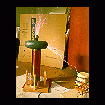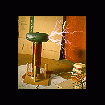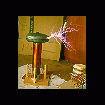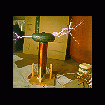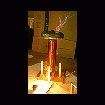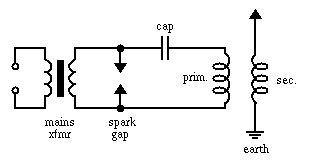Technical data:
| Secondary coil: | 10.5cm diam., 32cm high, 1000 turns 0.3mm enamelled wire on PVC tube, coated with polyurethan varnish. |
| Primary coil: | 20cm diam., 16 turns 1mm copper wire, spacing between turns 1cm, on wooden form. |
| Primary cap: | 8nF, plate stack type (4 in parallel), PE dielectric. |
| Spark gap: | 5 copper tubes (2.5cm diam, 10cm long), spacing 1mm, transformer is connected to the outer tubes. |
| Primary transformer: | 10kV, 100mA oil burner ignition transformers (5 in parallel). |
| Streamer length: | something around 50cm (20"), arcs to ground more. |

tesla coil running
